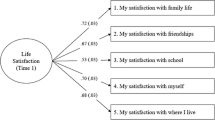Abstract
The Brief Multidimensional Students’ Life Satisfaction Scale (BMSLSS) was developed in response to an increasing interest in the assessment, monitoring, and promotion of positive child and youth well-being. This study further examined the psychometric support for the brief instrument by evaluating its demographic relationships, internal consistency reliability and one-year test-retest reliability, and predictive validity in a sample of 284 secondary school students in the USA who were administered the BMSLSS and criterion measures on two occasions, one year apart. Consistent with predictions, the results indicated acceptable internal consistency, moderate one-year stability coefficient, and moderate, but robust cross-sectional and longitudinal correlations with multiple indices of student engagement in their schooling. The results provide further support for the psychometric properties of the BMLSS.
Similar content being viewed by others
References
Andrews, F. M., & Withey, S. B. (1976). Social indicators of well-being: American’s perceptions of life quality. New York: Plenum.
Andrews, F. M., & Robinson, J. P. (1991). Measures of subjective well-being. Measures of personality and social psychological attitudes (pp. 61–114). San Diego: Academic.
Antaramian, S., & Huebner, E. S. (2009). Stability of adolescents’ multidimensional life satisfaction reports. Journal of Psychoeducational Assessment, 27, 421–425.
Appleton, J. J., Christenson, S. L., Kim, D., & Reschly, A. (2006). Measuring cognitive and psychological engagement: validation of the student engagement instrument. Journal of School Psychology, 44, 427–445.
Ben-Arieh, A. (2008). The child indicators movement: past, present, and future. Child Indicators Research, 1, 3–16.
Betts, J., Appleton, J. J., Reschly, A. L., Christenson, S. L., & Huebner, E. S. (2010). A study of the factorial invariance of the school engagement instrument (SEI): results from middle and high school students. School Psychology Quarterly, 25, 84–93.
Diener, E., & Seligman, M. E. P. (2004). Beyond money: toward and economy of well-being. Psychological Science in the Public Interest, 5, 1–31.
Diener, E., Suh, E. M., Lucas, R. E., & Smith, H. L. (1999). Subjective well-being: three decades of progress. Psychological Bulletin, 12, 276–302.
Frisch, M. B. (2006). Quality of life therapy. New York: Wiley.
Frisch, M. B., Clark, M. P., Rouse, S. V., Rudd, M. D., Paweleck, J. K., Greenston, A., et al. (2005). Predictive and treatment validity of life satisfaction and the quality of life inventory. Assessment, 12, 66–78.
Gilman, R., & Huebner, E. (1999). Review of life satisfaction measures for adolescents. Behaviour Change, 17, 178–195.
Greenspoon, P. J., & Saklofske, D. H. (2001). Toward an integration of subjective well-being and psychopathology. Social Indicators Research, 54, 81–108.
Huebner, E. S., Suldo, S. M., Valois, R. F., Drane, J. W., & Zullig, K. J. (2004). Brief multidimensional students’ life satisfaction scale: gender, race, and grade effects. Psychological Reports, 94, 351–356.
Huebner, E. S., Valois, R. F., Suldo, S. M., Smith, L. C., McKnight, C. G., Seligson, J. L., et al. (2004). Perceived quality of life: a neglected component of adolescent health and intervention. Journal of Adolescent Health, 34, 270–278.
Huebner, E. S., Seligson, J. L., Valois, R. F., & Suldo, S. M. (2006a). A review of the brief multidimensional students’ life satisfaction scale. Social Indicators Research, 79, 477–484.
Huebner, E. S., Suldo, S. M., Valois, R. F., & Drane, J. W. (2006b). The brief multidimensional students’ life satisfaction scale: sex, race, and grade effects for applications with middle school students. Applied Research in Quality of Life, 1, 211–216.
Huebner, E. S., Gilman, R., & Suldo, S. M. (2007). Assessing perceived quality of life in children and youth. In S. R. Smith & L. Handler (Eds.), The clinical assessment of children and adolescents: A practitioners’ handbook (pp. 347–363). Mahwah: Erlbaum.
Lewinsohn, P., Redner, J., & Seely, J. (1991). The relationship between life satisfaction and psychosocial variables: New perspectives. In F. Strack, M. Argyle, & N. Schwartz (Eds.), Subjective well-being (pp. 193–212). New York: Plenum.
Lewis, A. D., Huebner, E.S., Malone, P.S., & Valois, R.F. (in press). Life satisfaction and student engagement in adolescents. Journal of Youth and Adolescence.
Lucas, R. E., Diener, E., & Suh, E. (1996). Discriminant validity of well-being measures. Journal of Personality and Social Psychology, 71, 616–628.
Martin, K., Huebner, E.S., & Valois, R.F. (2008). Does life satisfaction predict victimization experiences in adolescence? Psychology in the Schools, 45, 705-714.
Reschly, A. L., Huebner, E. S., Appleton, J. J., & Antaramian, S. (2008). Engagement as flourishing: the contribution of positive affect and coping to adolescents’ engagement at school and with learning. Psychology in the Schools, 45, 419–431.
Seligson, J. L., Huebner, E. S., & Valois, R. F. (2003). Preliminary development and validation of the brief multidimensional students’ life satisfaction scale. Social Indicators Research, 61, 121–145.
Seligson, J. L., Huebner, E. S., & Valois, R. F. (2005). Validation of a brief life satisfaction scale with elementary school students. Social Indicators Research, 73, 355–374.
Suldo, S. M., & Huebner, E. S. (2004). Does life satisfaction moderate the effects of stressful life events on psychopathological behavior during adolescence? School Psychology Quarterly, 19, 93–105.
Suldo, S. M., & Shaffer, E. J. (2008). Looking beyond psychopathology: the dual-factor model of mental health in youth. School Psychology Review, 37, 52–68.
Acknowledgement
Thanks are extended to Jerlean Noble for assistance in wordprocessing the manuscript.
Author information
Authors and Affiliations
Corresponding author
Rights and permissions
About this article
Cite this article
Huebner, E.S., Antaramian, S.P., Hills, K.J. et al. Stability and Predictive Validity of the Brief Multidimensional Students’ Life Satisfaction Scale. Child Ind Res 4, 161–168 (2011). https://doi.org/10.1007/s12187-010-9082-2
Accepted:
Published:
Issue Date:
DOI: https://doi.org/10.1007/s12187-010-9082-2




